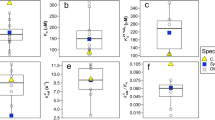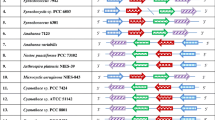Abstract
Cyanobacteria are a group of oxygenic phototrophs that have existed for at least 3.5 Ga. Photosynthetic CO2 assimilation by cyanobacteria occurs via the Calvin cycle, with RuBisCO, its key enzyme, having very low affinity to CO2. This is due to the fact that atmospheric CO2 concentration in Archaean, when the photosynthetic apparatus evolved, was several orders higher than now. Later, in the epoch of Precambrian microbial communities, CO2 content in the atmosphere decreased drastically. Thus, present-day phototrophs, including cyanobacteria, require adaptive mechanisms for efficient photosynthesis. In cyanobacterial cells, this function is performed by the CO2-concentrating mechanism (CCM), which creates elevated CO2 concentrations in the vicinity of RuBisCO active centers, thus significantly increasing the rate of CO2 fixation in the Calvin cycle. CCM has been previously studied only for freshwater and marine cyanobacteria. We were the first to investigate CCM in haloalkaliphilic cyanobacteria from soda lakes. Extremophilic haloalkaliphilic cyanobacteria were shown to possess a well-developed CCM with the structure and functional principles similar to those of freshwater and marine strains. Analysis of available data suggests that regulation of the amount of inorganic carbon transported into the cell is probably the general CCM function under these conditions.
Similar content being viewed by others
References
Raven, J.A., Cockell, C.S., and De La Rocha, C.L., The evolution of inorganic carbon concentrating mechanisms in photosynthesis, Philos. Trans. R. Soc. Lond. B. Biol. Sci., 2008, vol. 363, pp. 2641–2650.
Price, G.D., Badger, M.R., Wodger, F.J., and Long, B.M., Advances in understanding the cyanobacterial CO2-concentrating mechanism (CCM): functional components, Ci transporters, diversity, genetic regulation and prospects for engineering into plants, J. Exp. Bot., 2008, vol. 59, pp. 1441–1461.
Price, G.D., Inorganic carbon transporters of the cyanobacterial CO2 concentrating mechanism, Photosynth. Res., 2011, vol. 109, pp. 47–57.
Kupriyanova, E.V., Sinetova, M.A., Cho, S.M., Park, Y.-I., Los, D.A., and Pronina N.A., CO2-concentrating mechanism in cyanobacterial photosynthesis: organization, physiological role and evolutionary origin, Photosynth. Res., 2013, vol. 117, pp. 133–146.
Moroney, J.V., Jungnick, N., DiMario, R.J., and Longstreth, D.J., Photorespiration and carbon concentrating mechanisms: two adaptations to high O2, low CO2 conditions, Photosynth. Res., 2013, vol. 117, pp. 121–131.
DeRuyter, Y.S. and Fromme, P., Molecular structure of the photosynthetic apparatus, in The Cyanobacteria: Molecular Biology, Genetics and Evolution, Herrero, A. and Flores, E., Eds., Norfolk: Caister, 2008, pp. 217–270.
Jordan, D.B. and Ogren, W.L., Species variation in the specificity of ribulose biphosphate carboxylase/oxygenase, Nature, 1981, vol. 291, pp. 513–515.
Tabita, F.R., Satagopan, S., Hanson, T.E., Kreel, N.E., and Scott, S.S., Distinct form I, II, III, and IV Rubisco proteins from the three kingdoms of life provide clues about Rubisco evolution and structure/function relationships, J. Exp. Bot., 2008, pp. 1515–1524.
Badger, M.R. and Spalding, M.H., CO2 acquisition, concentration and fixation in cyanobacteria and algae, in Photosynthesis: Physiology and Metabolism, Leegood, R.C., Sharkey, T.D., and von Caemmerer, S., Eds., Dordrecht: Kluwer, 2000, pp. 369–397.
Delwiche, C.F., Tracing the thread of plastid diversity through the tapestry of life, Am. Nat., 1999, vol. 154, pp. 164–177.
Badger, M.R., Hanson, D., and Price, G.D., Evolution and diversity of CO2 concentrating mechanisms in cyanobacteria, Funct. Plant Biol., 2002, vol. 29, no. 2, pp. 161–173.
Espie, G.S. and Kimber, M.S., Carboxysomes: cyanobacterial RubisCO comes in small packages, Photosynth. Res., 2011, vol. 109, pp. 7–20.
Cannon, G.C., Heinhorst, S., and Kerfeld, C.A., Carboxysomal carbonic anhydrases: structure and role in microbial CO2 fixation, Biochim. Biophys. Acta, 2010, vol. 1804, pp. 382–392.
Rae, B.D., Long, B.M., Badger, M.R., and Price, G.D., Functions, compositions, and evolution of the two types of carboxysomes: polyhedral micro-compartments that facilitate CO2 fixation in cyanobacteria and some proteobacteria, Microbiol. Mol. Biol. Rev., 2013, vol. 77, pp. 357–379.
Whitehead, L., Long, B.M., Price, G.D., and Badger, M.R., Comparing the in vivo function of α-carboxysomes and β-carboxysomes in two model cyanobacteria, Plant Physiol., 2014, vol. 165, pp. 398–411.
Kasting, J.F., Theoretical constraints on oxygen and carbon dioxide concentrations in the Precambrian atmosphere, Precambrian Res., 1987, vol. 34, pp. 205–229.
Zavarzin, G.A., Microbial biosphere, in Biosphere Origin and Evolution, Dobretsov, N.L., Kolchanov, N.A., Rosanov, A.Y., and Zavarzin, G.A., Eds., New York: Springer Science + Business Media, LLC, 2008, pp. 25–42.
Tcherkez, G.G., Farquhar, G.D., and Andrews, T.J., Despite slow catalysis and confused substrate specificity, all ribulose bisphosphate carboxylases may be nearly perfectly optimized, Proc. Natl. Acad. Sci. U. S. A., 2006, vol. 103, pp. 7246–7251.
Whitney, S.M., Houtz, R.L., and Alonso, H., Advancing our understanding and capacity to engineer nature’s CO2-sequestering enzyme Rubisco, Plant Physiol., 2011, vol. 155, pp. 27–35.
Galmés, J., Kapralov, M.V., Andralojc, P.J., Conesa, M.A., Keys, A.J., Parry, M.A., and Flexas, J., Expanding knowledge of the Rubisco kinetics variability in plant species: environmental and evolutionary trends, Plant Cell Environ., 2014, vol. 37, pp. 1989–2001.
Jungnick, N., Ma, Y., Mukherjee, B., Cronan, J.C., Speed, D.J., Laborde, S.M., Longstreth, D.J., and Moroney, J.V., The carbon concentrating mechanism in Chlamydomonas reinhardtii: finding the missing pieces, Photosynth. Res., 2014, vol. 121, pp. 159–173.
Field, C.B., Behrenfeld, M.J., Randerson, J.T., and Falkowski, P., Primary production of the biosphere: integrating terrestrial and oceanic components, Science, 1998, vol. 281, pp. 237–240.
Cameron, J.C., Wilson, S.C., Bernstein, S.L., and Kerfeld, C.A., Biogenesis of a bacterial organelle: the carboxysome assembly pathway, Cell, 2013, vol. 155, pp. 1131–1140.
Kinney, J.N., Axen, S.D., and Kerfeld, C.A., Comparative analysis of carboxysome shell proteins, Photosynth. Res., 2011, vol. 109, pp. 21–32.
Sonnenfeld, P., Brines and Evaporites, Orlando: Academic, 1984.
Marcus, Y., Distribution of inorganic carbon among its component species in cyanobacteria: do cyanobacteria in fact actively accumulate inorganic carbon?, J. Theor. Biol., 1997, vol. 187, pp. 31–45.
Kaplan, A. and Reinhold, L., CO2 concentrating mechanisms in photosynthetic microorganisms, Annu. Rev. Plant Physiol. Plant Mol. Biol., 1999, vol. 50, pp. 539–570.
Pronina, N.A., The organization and physiological role of the CO2-CM in microalgal photosynthesis, Russ. J. Plant Physiol., 2000, vol. 47, no. 5, pp. 706–714.
Omata, T., Price, G.D., Badger, M.R., Okamura, M., Gohta, S., and Ogawa, T., Identification of an ATP-binding cassette transporter involved in bicarbonate uptake in the cyanobacterium Synechococcus sp. strain PCC7942, Proc. Natl. Acad. Sci. U. S. A., 1999, vol. 96, pp. 13571–13576.
Shibata, M., Katoh, H., Sonoda, M., Ohkawa, H., Shimoyama, M., Fukuzawa, H., Kaplan, A., and Ogawa, T., Genes essential to sodium-dependent bicarbonate transport in cyanobacteria. Function and phylogenetic analysis, J. Biol. Chem., 2002, vol. 277, pp. 18658–18664.
Zhang, P.P., Battchikova, N., Jansen, T., Appel, J., Ogawa, T., and Aro, E.M., Expression and functional roles of the two distinct NDH-1 complexes and the carbon acquisition complex NdhD3/NdhF3/CupA/Sll1735 in Synechocystis sp. PCC 6803, Plant Cell, 2004, vol. 16, pp. 3326–3340.
Price, G.D., Woodger, F.J., Badger, M.R., Howitt, S.M., and Tucker, L., Identification of a SulP-type bicarbonate transporter in marine cyanobacteria, Proc. Natl. Acad. Sci. U. S. A., 2004, vol. 101, pp. 18228–18233.
Shibata, M., Ohkawa, H., Kaneko, T., Fukuzawa, H., Tabata, S., Kaplan, A., and Ogawa, T., Distinct constitutive and low-CO2-induced CO2 uptake systems in cyanobacteria: genes involved and their phylogenetic relationship with homologous genes in other organisms, Proc. Natl. Acad. Sci. U. S. A., 2001, vol. 98, pp. 11789–11794.
Maeda, S., Badger, M.R., and Price, G.D., Novel gene products associated with NdhD3/D4-containing NDH-1 complexes are involved in photosynthetic CO2 hydration in the cyanobacterium, Synechococcus sp. PCC7942, Mol. Microbiol., 2002, vol. 43, pp. 425–435.
Badger, M.R., Price, G.D., Long, B.M., and Woodger, F.J., The environmental plasticity and ecological genomics of the cyanobacterial CO2 concentrating mechanism, J. Exp. Bot., 2006, vol. 57, no. 2, pp. 249–265.
Badger, M.R. and Price, G.D., CO2 concentrating mechanisms in cyanobacteria: molecular components, their diversity and evolution, J. Exp. Bot., 2003, vol. 54, no. 383, pp. 609–622.
Carbonic Anhydrase: Mechanism, Regulation, Links to Disease, and Industrial Applications. Subcellular Biochemistry 75, Frost, S.C. and McKenna, R., Eds., Dordrecht: Springer Science+Business Media, 2014.
Cot, S.S., So, A.K., and Espie, G.S., A multiprotein bicarbonate dehydration complex essential to carboxysome function in cyanobacteria, J. Bacteriol., 2008, vol. 190, pp. 936–945.
Penã, K.L., Castel, S.E., de Araujo, C., Espie, G.S., and Kimber, M.S., Structural basis of the oxidative activation of the carboxysomal γ-carbonic anhydrase, CcmM, Proc. Natl. Acad. Sci. U. S. A., 2010, vol. 107, pp. 2455–2460.
Rae, B.D., Long, B.M., Whitehead, L.F., Förster B., Badger, M.R., and Price, G.D., Cyanobacterial carboxysomes: microcompartments that facilitate CO2 fixation, J. Mol. Microbiol. Biotechnol., 2013, vol. 23, pp. 300–307.
Cannon, G.C., Bradburne, C.E., Aldrich, H.C., Baker, S.H., Heinhorst, S., and Shively, J.M., Microcompartments in prokaryotes: carboxysomes and related polyhedra, Appl. Environ. Microbiol., 2001, vol. 67, pp. 5351–5361.
Zavarzin, G.A., Epicontinental soda lakes as presumable relic biotopes of formation of terrestrial biota, Mikrobiologiya, 1993, vol. 62, pp. 477–479.
Dubinin, A.V., Gerasimenko, L.M., and Zavarzin, G.A., Ecophysiology and species diversity of cyanobacteria in Lake Magadi, Microbiology (Moscow), 1995, vol. 64, pp. 717–721.
Mikhodyuk, O.S., Gerasimenko, L.M., Akimov, V.N., Ivanovsky, R.N., and Zavarzin, G.A., Ecophysiology and polymorphism of the unicellular extremely natronophilic cyanobacterium Euhalothece sp. Z-M001 from Lake Magadi, Microbiology (Moscow), 2008, vol. 77, no. 6, pp. 717–725.
Gerasimenko, L.M., Mityushina, L.L., and Namsaraev, B.B., Microcoleus mats from alkaliphilic and halophilic communities, Microbiology (Moscow), 2003, vol. 72, pp. 71–79.
Namsaraev, Z.B., Gorlenko, V.M., Buryukhaev, S.P., Barkhutova, D.D., Dambaev, V.B., Dulov, L.E., Sorokin, D.Yu., and Namsaraev, B.B., Water regime and variations in hydrochemical characteristics of the soda salt Lake Khilganta (Southeastern Transbaikalia), Water Res., 2010, vol. 37, no. 4, pp. 513–519.
Mikhodyuk, O.S., Zavarzin, G.A., and Ivanovsky, R.N., Transport systems for carbonate in the extremely natronophilic cyanobacterium Euhalothece sp., Microbiology (Moscow), 2008, vol. 77, no. 4, pp. 412–418.
Samylina, O.S., Carbon-concentrating mechanism as a component of adaptation of an extremely halophilic cyanobacterium ‘Euhalothece natronophila’ to soda lake environment, Extended Abstract Cand. Sci. (Biol.) Dissertation, Moscow, 2008.
Samylina, O.S. and Ivanovsky, R.N., CO2-concentrating mechanism of cyanobacteria, Trudy Instituta mikrobiologii imeni S.N. Vinogradskogo (Proc. Winogradsky Inst. Microbiol.), vol. 15. Photosynthetic Bacteria, Gal’chenko, V.F., Ed., Moscow: MAKS, 2010, pp. 86–117.
Kupriyanova, E., Villarejo, A., Markelova, A., Gerasimenko, L., Zavarzin, G., Samuelsson, G., Los, D.A., and Pronina, N., Extracellular carbonic anhydrases of the stromatolite-forming cyanobacterium Microcoleus chthonoplastes, Microbiology (UK), 2007, vol. 153, pp. 1149–1156.
Kupriyanova, E.V., Sinetova, M.A., Markelova, A.G., Allakhverdiev, S.I., Los, D.A., and Pronina, N.A., Extracellular β-class carbonic anhydrase of the alkaliphilic cyanobacterium Microcoleus chthonoplastes, J. Photochem. Photobiol., 2011, vol. 103, pp. 78–86.
Dudoladova, M.V., Kupriyanova, E.V., Markelova, A.G., Sinetova, M.P., Allakhverdiev, S.I., and Pronina, N.A., The thylakoid carbonic anhydrase associated with photosystem II is the component of inorganic carbon accumulating system in cells of halo- and alkaliphilic cyanobacterium Rhabdoderma lineare, Biochimica et Biophysica Acta-Bioenergetics, 2007, vol. 1767, pp. 616–623.
Kupriyanova, E.V., Lebedeva, N.V., Dudoladova, M.V., Gerasimenko, L.M., Alekseeva, S.G., Pronina, N.A., and Zavarzin, G.A., Carbonic anhydrase activity of alkalophilic cyanobacteria from soda lakes, Russ. J. Plant Physiol., 2003, vol. 50, pp. 532–539.
Author information
Authors and Affiliations
Corresponding author
Additional information
Original Russian Text © E.V. Kupriyanova, O.S. Samylina, 2015, published in Mikrobiologiya, 2015, Vol. 84, No. 2, pp. 144–159.
Rights and permissions
About this article
Cite this article
Kupriyanova, E.V., Samylina, O.S. CO2-concentrating mechanism and its traits in haloalkaliphilic cyanobacteria. Microbiology 84, 112–124 (2015). https://doi.org/10.1134/S0026261715010075
Received:
Published:
Issue Date:
DOI: https://doi.org/10.1134/S0026261715010075




